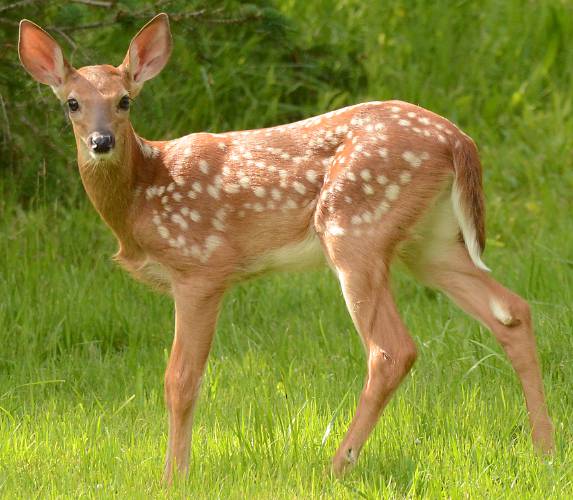Speaking of Nature: The fawns have arrived: Understanding the first months of life for a baby deer

This fawn was only about three weeks old when I spotted it in my own yard. Its twin was nearby and the pair eventually melted into some thicker vegetation across the quiet country road that I live on. PHOTO BY BILL DANIELSON
| Published: 06-24-2025 12:20 PM |
Last week, we observed the first day of summer and Nature seemed to acknowledge the occasion with a change in the weather. The first three weeks of June saw a continuation of the rain that has dampened our collective spirits for weeks and months. Now, in the first full week of summer we have been roasted with high temperatures. This naturally led to some epic humidity, which has been a real treat for anyone who works in an office without air conditioning. Oh what fun it has been.
That being said, the calendar of events that we can observe outside has not changed. Timing is everything and all of the major players have hit their cues. The fireflies have begun their twinkling nuptial flights, female turtles have begun to venture out in search of suitable nesting sites, and the white-tailed does have given birth; right on schedule for all concerned. Today I want to focus on that last group of characters in Nature’s play – the baby deer that we call fawns.
Female deer (called “does”) will typically enter estrus in late fall. The timing of this event is determined by the shortening “photoperiod” experienced at that time. Basically, the photoperiod is the amount of daylight received at a particular time of year. As the days get shorter, the breeding season (also known as the “rut”) begins and this generally occurs in the month of November. The average gestation period for the white-tailed deer is 201 days, which means that does will begin to “drop” their fawns in June.
First-time mothers generally have a single fawn, while older and healthier does will typically have twins. The little babies can weigh as little as 6 pounds and they are exceptionally vulnerable in their first weeks of life. As a result, the processes of natural selection and evolution have fashioned the best script for deer to follow to maximize the survival of fawns. This has resulted in a process that many humans often misinterpret, so listen carefully.
Newborn fawns do not have active scent glands, which means that they are as “invisible” to their olfactory-dependent mammalian predators as they can possibly be. The female deer understand this and so they actively stay away from their babies for as long as possible; only visiting them four times per day for nursing. When their mothers are keeping their distance, the fawns keep still; curled up in a ball on the ground and pretending that they don’t exist. So, if you happen to come across a fawn that appears to be “all alone,” then that is exactly what you are supposed to think. The fawn is doing everything correctly and you should ignore any mothering instinct you might have and just leave the fawn alone.
After about a month of this stealth technique, the fawns will finally be old enough to begin to follow their mothers around on foraging expeditions. It turns out that there is a lot for the little deer to learn about the world and the does have to introduce them to what is edible in the world around them. There is also a lot to learn about what is dangerous and what is not and this clearly depends on the exact location where the fawns are born. In most places, humans are to be avoided, but there are special locations, like the Sachuest Point National Wildlife Refuge in Rhode Island, where humans are not feared to the same degree. In such rare and wonderful locales, fawns can be watched with rare intimacy.
The main predators of fawns will be coyotes, bobcats and dogs. Then, of course, there are humans and their vehicles. I have already passed a few dead fawns in my travels, but (so far) I have not contributed to any of the mortalities. I’d like to think that my deliberate driving has had something to do with this. At this time of year I drive a lot slower and try to stay away from the edge of the road whenever possible. The tiniest members of the deer herd need a chance to survive an encounter with a vehicle if they are to learn about the dangers of the road, so slowing down gives them a chance.
Fawns generally lose their spots by the time November rolls around again and then Nature intervenes once again. Young males (also known as “bucks”) will leave their mother’s company at about one year of age, while the young does will often stay with her for two years. This long relationship between mothers and daughters probably allows the greatest education possible for the young females, which will also result in the highest possible success for the species. In their second year of life the young females will finally breed. Just 201 days later, the newest mothers will give birth to their single fawns, which may also allow the new mothers a chance to focus on just one baby at a time.
Article continues after...
Yesterday's Most Read Articles
 A comforting craft: Greenfield knitting circle donates to hospital, police and school
A comforting craft: Greenfield knitting circle donates to hospital, police and school
 The hot new spot in Shelburne Falls: Hotfire Bar and Grill feels in many ways like a home kitchen
The hot new spot in Shelburne Falls: Hotfire Bar and Grill feels in many ways like a home kitchen
 New Whately highway superintendent settles in
New Whately highway superintendent settles in
 Amid dwindling membership, Northfield Kiwanis Club to dissolve
Amid dwindling membership, Northfield Kiwanis Club to dissolve
 Grants to illuminate Massachusetts history for Revolution’s 250th anniversary
Grants to illuminate Massachusetts history for Revolution’s 250th anniversary
 MassDEP to handle First St. cleanup in Turners Falls; site slated for affordable housing
MassDEP to handle First St. cleanup in Turners Falls; site slated for affordable housing
So keep your eyes peeled for all sorts of wildlife in the road. The turtles are out, the fawns will soon be scampering around with their mothers and the wet weather also encourages frogs to get out and explore the world. Whenever possible take your foot off the gas a little and give everyone a chance to cross the road without getting hit. And if you live in a rural area, make a point of looking out the window during the twilight hours around sunset. If you are very lucky, you might catch sight of a frisky young fawn running, jumping and playing with an exuberance that only youth can produce.
Bill Danielson has been a professional writer and nature photographer for 28 years. He has worked for the National Park Service, the US Forest Service, the Nature Conservancy and the Massachusetts State Parks and he currently teaches high school biology and physics. For more in formation visit his website at www.speakingofnature.com, or go to Speaking of Nature on Facebook.






 Speaking of Nature: Bouncing through the grass: The flight window for the northern pearly-eye is July
Speaking of Nature: Bouncing through the grass: The flight window for the northern pearly-eye is July World of wonder: Walter Wick’s dynamic photographic illustrations at Norman Rockwell Museum
World of wonder: Walter Wick’s dynamic photographic illustrations at Norman Rockwell Museum Local authors up for statewide awards: Four Franklin County authors nominated in four different Mass Book Awards categories
Local authors up for statewide awards: Four Franklin County authors nominated in four different Mass Book Awards categories
